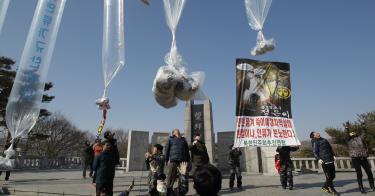Just when long-time North Korea watchers thought they had seen it all, Pyongyang managed to surprise them.
The world has seemingly become inured to North Korea’s steadily escalating nuclear and missile threats and extensive human-rights atrocities. Launches of new, more deadly ICBMs no longer merit coverage in U.S. media. But Pyongyang has come up with a new way to gain attention and show its scorn for South Korea—sending trash and manure via balloons. In other words, flying feces.
On May 29, some South Koreans were awakened to emergency text messages of “air raid preliminary warning” over unidentified objects traveling over the demilitarized zone. The South Korean military subsequently said it detected 260 North Korean balloons that fell across the country, including in Seoul and the southeasternmost province. The balloons carried plastic bottles, batteries, shoe parts … and excrement.
Pyongyang’s latest antics are even more petulant and disdainful than usual, as underscored by the brazen statement by Kim Yo-jong—the North Korean leader’s powerful sister—that South Koreans should regard the filth-laden balloons as “sincere presents to the goblins of liberal democracy.”
>>> Precarious Year Ahead for the Korean Peninsula
However, beyond the mirthful tongue-in-cheek media commentary, North Korea’s action raises several serious issues. South Korea citizens may worry that the balloons transiting into South Korea exposes vulnerability to North Korean attacks had the balloons been equipped with biological or chemical warfare agents, which the regime has extensive stocks off.
As Kim’s belligerent statement makes clear, Pyongyang launched its balloons to get Seoul to stop South Korean human-rights activists who use balloons to send propaganda leaflets, money, Bibles, and computer thumb drives into the North.
Pyongyang perceives any outside information seeping into the hermetically sealed Hermit Kingdom as a direct threat to regime stability and national security. Kim chastised the “scum-like clans” of South Korea for criticizing the regime’s “freedom of expression of the North Korean people” as a violation of international law when Seoul had allowed “despicable article-scattering” balloons to fly north.
Having equated the two Korea’s balloon launches, Kim Yo-jong now called on South Korea to prevent future northward balloons, otherwise Pyongyang would reciprocate by scattering “rubbish dozens of times more than those being scattered to us.” In 2020, Kim demanded that then-President Moon Jae-in stop South Korean groups from sending balloons northward.
At that time, Moon quickly acquiesced, declaring the South Korean propaganda leaflets as “harmful to national security,” directing police to prevent further balloon flights, and his political party passed legislation to “crack down” on the leaflet flights. Last year, the South Korean Constitutional Court ruled the law was an unconstitutional infringement on the freedom of speech.
Pyongyang previously vowed “crushing physical blows of higher intensity” if balloons continued to be sent to the North and warned that its artillery units would shell the areas where balloons are launched. In 2014, North Korea fired at balloons flying toward its territory, triggering an exchange of fire with a South Korean military unit after some rounds landed south of the border.
>>> Should the United States Recognize North Korea as a Nuclear Power?
In 2022, Kim Yo-jong declared that North Korea would “wip[e] out the South Korean authorities” if “rubbish” continued to be flown from South Korea. Last week, North Korea Vice Minister of Defense Kim Kang-il warned that South Korea’s “scattering leaflets by use of balloons is a dangerous provocation.”
The same year, North Korean drones penetrated South Korean airspace including near the presidential residence. The South Korean military was heavily criticized for its failure to intercept the drones. In response, the Yoon administration vowed to boost the country’s drone-related capabilities and readiness and established a joint drone command in 2024.
Pyongyang’s abrogation last year of an inter-Korean risk reduction agreement and continued refusal to respond to hotline communications reduces opportunities for preventing inadvertent miscalculation or military clashes.
President Yoon Suk Yeol is now faced with the dilemma of capitulating to regime demands or responding forcefully. He repeatedly criticized his predecessor’s conciliatory approach to North Korea and vowed to respond resolutely to any North Korean provocation. But defying Pyongyang’s demands or shooting at the balloons risks escalation.
This piece originally appeared in The National Interest https://nationalinterest.org/feature/north-korea%E2%80%99s-bizarre-balloon-tactics-sending-trash-south-korea-211264





